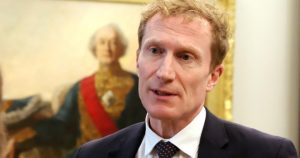Bank of England holds interest rates at 4.75%

Unlock the Editor’s Digest for free
Roula Khalaf, Editor of the FT, selects her favourite stories in this weekly newsletter.
The Bank of England has kept interest rates on hold at 4.75 per cent as it seeks to contend with both stubborn inflation and lacklustre growth.
In a six-to-three decision, most members of the Monetary Policy Committee warned that recent increases in wages and prices had “added to the risk of inflation persistence”, damping hopes of rapid rate cuts in 2025.
“We think a gradual approach to future interest rate cuts remains right,” said Andrew Bailey, BoE governor. “But with the heightened uncertainty in the economy, we can’t commit to when or by how much we will cut rates in the coming year.”
He added that the BoE needed to make sure it could meet its “2 per cent inflation target on a sustained basis”.
Rob Wood, UK economist at Pantheon Macroeconomics, said the minutes of the meeting were “cautious and therefore more hawkish than that six-to-three headline would suggest”.
He added that inflation was likely to rise above 3 per cent in the spring, “with highly visible price rises that could destabilise inflation expectations that are already above average and rising”.
The BoE’s relatively tough language came a day after the US Federal Reserve signalled that it would slow the pace of its rate cuts next year amid signs of persistent inflation.
The UK central bank is contending with rising price pressures alongside two consecutive months of falling GDP, complicating its own plans for interest rate cuts next year.
Thursday’s decision, which was in line with forecasts from economists polled by Reuters, comes a day after data showed that UK inflation rose to 2.6 per cent last month, from 2.3 per cent in October.
But the three MPC members favouring a quarter-point reduction — deputy governor Dave Ramsden, Alan Taylor and Swati Dhingra — cited “sluggish demand” and a weaker labour market.
“Given the evolving balance of risks, a less restrictive policy rate was warranted,” they said.
BoE staff now expect zero growth in the final quarter of this year, weaker than forecast in November.
“Most indicators of UK near-term activity have declined,” the central bank said on Friday.
It added that risks to global growth and inflation from geopolitical tensions and trade policy uncertainty had “increased materially” — an apparent reference to US president-elect Donald Trump’s plans to increase tariffs on imports to the US.
Sterling and gilt yields fell slightly after the widely expected decision to hold rates. The pound dipped to $1.261 after the BoE’s announcement, though it was still up 0.3 per cent on the day.
The yield on rate-sensitive two-year government bonds edged downwards to 4.46 per cent.
In recent weeks, however, yields on government debt have risen, as investors have been unnerved by inflation data and the Labour government’s Budget plans for extra borrowing.
Traders still expect the BoE to make two quarter-point cuts next year — the same as immediately before Thursday’s decision. That compares with the four the market expected as recently as October.
“The voting was more dovish than the market was expecting, suggesting it has gone too far recently to price out rate cuts for next year,” said Lee Hardman, MUFG’s senior currency analyst.
The BoE cut rates by a quarter point at its previous meeting in November, but signalled at the time that another reduction was unlikely until 2025. It has cut rates twice in 2024 and is due to announce its next rates decision on February 6.
#Bank #England #holds #interest #rates







